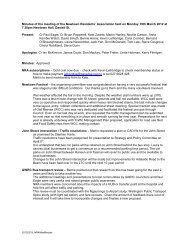Draft Town Belt Management Plan - Wellington City Council
Draft Town Belt Management Plan - Wellington City Council
Draft Town Belt Management Plan - Wellington City Council
You also want an ePaper? Increase the reach of your titles
YUMPU automatically turns print PDFs into web optimized ePapers that Google loves.
flanks of the ridges. The <strong>Town</strong> <strong>Belt</strong> comprises a significant portion of this. The character is<br />
enhanced by pockets of green ‘unmanaged’ land too steep for development. The landform and<br />
vegetation cover of the <strong>Town</strong> <strong>Belt</strong> and its relationship to the city and suburbs is a significant and<br />
unique feature of <strong>Wellington</strong>.<br />
4.1.2 <strong>Town</strong> <strong>Belt</strong> landscape change<br />
The complex story of interaction between people and the <strong>Town</strong> <strong>Belt</strong> and the resulting landscape<br />
change began long before the <strong>Town</strong> <strong>Belt</strong> was planned in 1839.<br />
Māori settlement: During the long period of Māori settlement, parts of the land now known as<br />
<strong>Town</strong> <strong>Belt</strong> were occupied by pā and buildings and spaces ancillary to the functioning of the pā. But<br />
most of the land was heavily wooded with trees, including pukatea, rata, totara, and rewarewa.<br />
These woodlands were rich with birds and berries, which were a cultivated food source for Māori.<br />
The streams of the <strong>Town</strong> <strong>Belt</strong> were home to tuna/eels, kokopu, koaro, and other freshwater fish<br />
species. Landscape features, such as the ridgelines, were valued for lookouts, garden sites and other<br />
activities.<br />
The land was also used for recreation activities, which were often related to learning skills for later<br />
in life. Then, as now, the landscape was modified in response to a range of values specific to that<br />
time and social context.<br />
19 th century developments: The process of European settlement saw rapid change in the<br />
landscape that is now the <strong>Town</strong> <strong>Belt</strong>. These changes were closely tied to the changing needs and<br />
values of the people of the city.<br />
Soon after European settlement in 1840, trees were cleared from the <strong>Town</strong> <strong>Belt</strong> for firewood and<br />
house building. In the 1870s large areas of the <strong>Town</strong> <strong>Belt</strong> were converted to pasture and leased to<br />
local farmers to provide milk for the developing city.<br />
This wholesale clearance and occupation had a huge visual impact on the city. By the turn of the<br />
19 th century the only native forest remaining on Original <strong>Town</strong> <strong>Belt</strong> was in the Botanic Garden.<br />
Development of facilities and utilities: From this early exploitative-type activity (firewood,<br />
building materials, grazing and quarrying) there was a shift to proactive park development,<br />
including a number of sports fields and Central Park. The development of city roads also had a<br />
significant impact on the <strong>Town</strong> <strong>Belt</strong> landscape. Much of this work occurred in the 1920s and ’30s<br />
using relief workers hired on <strong>Council</strong> and central government unemployment schemes.<br />
Since the 1950s development in the <strong>Town</strong> <strong>Belt</strong> has been predominantly associated with buildings<br />
and structures (including large water reservoirs) rather than landform change or resource use. The<br />
recreation section of this plan (section 6) details how the buildings and formal sports provision<br />
became established in the <strong>Town</strong> <strong>Belt</strong>.<br />
The alteration of the landform has been less widespread than vegetation change, but each incident<br />
has arguably had a more permanent and sometimes detrimental effect on the values of the <strong>Town</strong><br />
<strong>Belt</strong>. For example, the cutting of the road to Mt Victoria has left a prominent and irreparable mark<br />
in the natural landform, as has the development of sport and recreation parks, such as Hataitai<br />
Park, formed using fill from the Mt Victoria Tunnel.<br />
Several facilities have been removed during the tenure of the previous plan, including custodial<br />
houses on Berhampore Golf Course, Macalister Park and Goldies Brae, the dog pound at the golf<br />
course, Telecom houses on Te Ahumairangi Hill and the scout hall on Grant Road.<br />
Amenity plantings: The denuded nature of the <strong>Town</strong> <strong>Belt</strong> prompted city councillors and citizens<br />
of <strong>Wellington</strong> to plant areas to improve its visual appearance.<br />
26<br />
<strong>Draft</strong> <strong>Town</strong> <strong>Belt</strong> <strong>Management</strong> <strong>Plan</strong> October 2012





